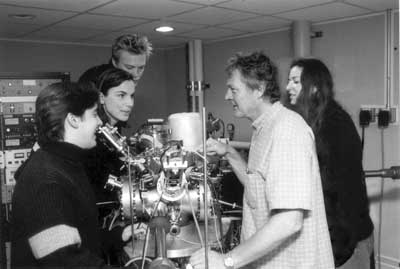 |
TOWARDS A
COLLABORATIVE CULTURE
by Susan
Martin
Artists have always been on the leading edge in
presenting new ideas to the general public and in shifting perception of
the collective reality. Like scientists, they set in motion processes that
can radically alter culture and society and bring about new meaning. The
intersection of art and science is nowhere more striking than in new media
where artists working with computers derive inspiration from the same
technological discoveries that drive much of contemporary science. Through
this common language new discoveries and collaborations are changing the
way traditional disciplines relate and interact—dispelling decades of
misconception about the rigid division of "two cultures" put forth by C.P.
Snow in the late 1950s. Based on mutual respect and dialogue, this union
of opposites creates an opportunity for the emergence of a third culture
that explores the uncharted intellectual terrain among the arts, the
humanities, and the sciences.
"Zero@wavefunction: nano dreams and
nightmares," a collaboration between Victoria Vesna, chair of the
Department of Design | Media Arts (D|MA), and James Gimzewski, a leading
expert on nanotechnology and a professor in UCLA's Department of Chemistry
and Biochemistry, is just such an exploration. Negotiating the gap between
the canon of rationality and the fluid poetic of art, Gimzewski and Vesna
set about to make nanoscience more accessible and understandable to the
broader public. A true collaboration based on interest in each other's
worlds, "Zero@wavefunction" is both an interactive website
(http:
//notime.arts.ucla.edu/zerowave) |

Left to right:
Andrew Pelling (physical chemistry student), professor
Victoria Vesna, Pete Conolly '98 (diredtor of D | MA's
Creative Technology Lab), professor James Gimzewski and
Cathy Skibo (physical chemistry student) looking at the
ultra high vacuum chamber that houses a scanning
tunneling microscope, photo by Patricia
Williams | |
and an installation projected on a monumental scale based
on the way a nanoscientist manipulates individual molecules
(billion of times smaller than common human experience). The
project premiered at the Biennial of Electronic Art in
Australia and was recently chosen as one of seven
collaborative works to be presented at "ArtSci2002: New
Dimensions in Collaboration," an international symposium in
December to be held at the American Museum of Natural History
and the City University of New York Graduate
Center.
Vesna and Gimzewski began their dialogue only
last year as part of a conference—"From Networks to
Nanosystems"—organized by UC
Digital Arts Research Network and co-sponsored by SINAPSE
(Center for Social Interfaces and Networks Advanced
Programmable Simulations |
and Environments) (http://sinapse.arts.ucla.edu).
Gimzewski, at the leading edge of nanoscience, was fascinated
by the resulting discussion.
"I had just left IBM
research and suddenly was able to interact with new ideas and
culture," he says. "I could see new territory and wanted to
explore it."
Nanoscience, described in the
"Zero@wavefunction" project proposal as "a brave new world
within [which] there are dangers and immense opportunities,"
starts at the atomic level and extends humankind's control of
matter over ever-increasing levels of complexity up to
biological, materials, electronic, and mechanical systems.
For Vesna, too—whose work has been concerned with
experiments that connect networked environments to physical
public spaces—the meeting was an important one. "It was not
long
|
continued
|
|

